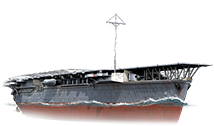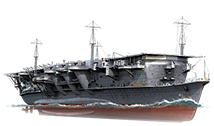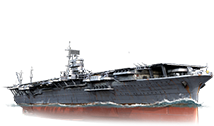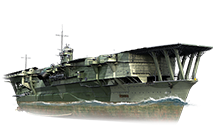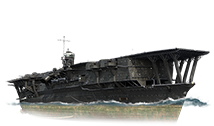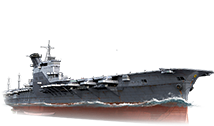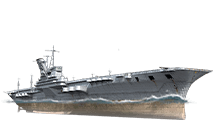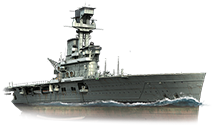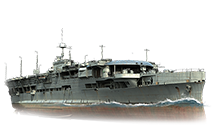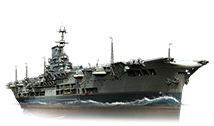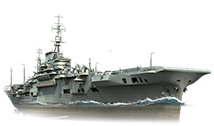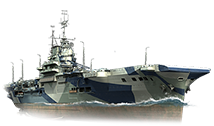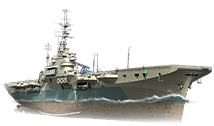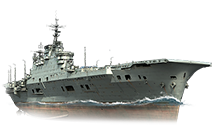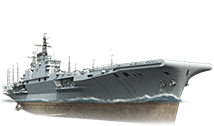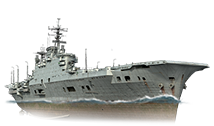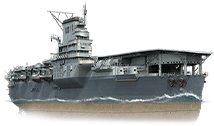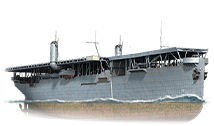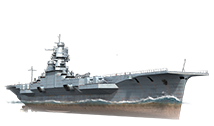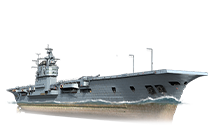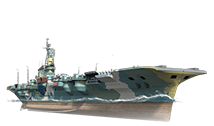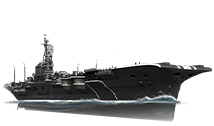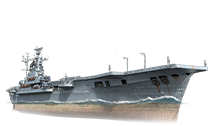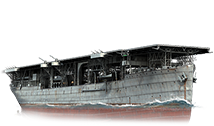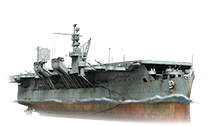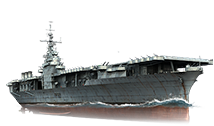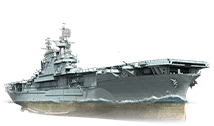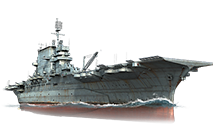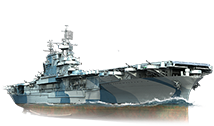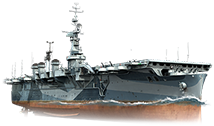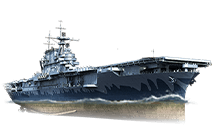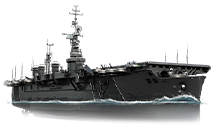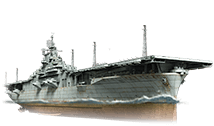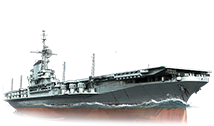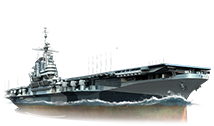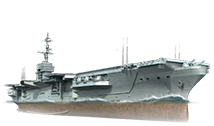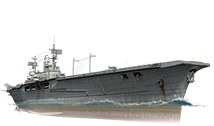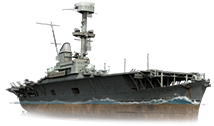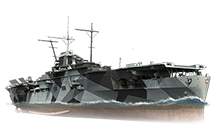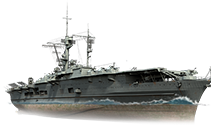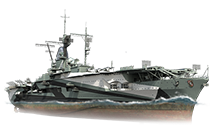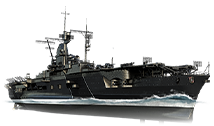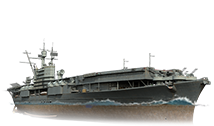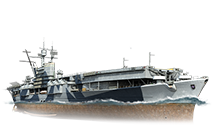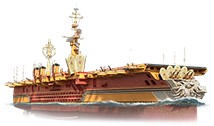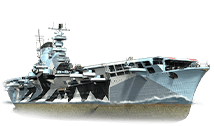Aircraft Carriers
| Revision as of 06:15, 11 September 2016 | Revision as of 23:26, 29 October 2020 changed rocket planes to attack aircraft | |||
11 intermediate revisions by 6 users not shown | ||||
| Line 1: | Line 1: | |||
| {{#vardefine:cur_class|AirCarrier}}{{AnnoWiki | {{#vardefine:cur_class|AirCarrier}}{{AnnoWiki | |||
| ? | |pic = Wows-{{lc:{{#var:cur_class}}}}.png | + | |pic = | |
| ? | | | + | |content = | |
| + | {{video|qjyQVM2sGAo|How to play carriers • [[Ship:Transcript of Video "How It Works: New Carriers Gameplay"|Transcript]]}} | |||
| + | [[Image:Wows-{{lc:{{#var:cur_class}}}}-icon.png|left|link=]]Aircraft carriers are basically floating airbases, transporting, servicing, launching planes into combat and recovering them, providing readily available air support to the naval fleets under their charge. While they can project power virtually anywhere on the battlefield, carriers are incredibly vulnerable when enemies have penetrated or circled your team's defenses, with no player-controlled guns and only AI-controlled secondaries to defend themselves. | |||
| ? | While the first ship-launched takeoffs, and subsequently | + | While the first ship-launched takeoffs, and subsequently airborne attacks, were made in the early 20th century, the then-immature development of heavier-than-air aircraft prevented them from having any major influence in World War I. During the interwar years, ongoing research resulted in the development of several converted and purpose-built ships that could not only launch aircraft, but eventually recover them as well. In addition, carrier-launched aircraft (or rather, air power in general) began to have longer ranges, superior flexibility and greater precision than naval guns of any size and make. Although fierce resistance from "big gun" battleship admirals initially limited carrier assets and development, it was in World War II — amply illustrated by the battles of Taranto, Pearl Harbor, Coral Sea, Midway and ''Operation Ten-Go'' — that the aircraft carrier clearly demonstrated its overwhelmingly superior ability to project naval power and took over the reins as the flagship of a navy from battleships, a trend that continues today. | |
| + | Playing an aircraft carrier differs quite a bit from playing the regular gunships. Aircraft carrier captains can, for the most part, keep their vessel far from the main action of a battle, and instead participate in the battle with individual squadrons of strike craft. You do not directly participate in combat, but are able to influence the flow of battle from a safe distance like no one else can, scouting, reinforcing a crumbling flank, providing additional presence to a sector that your team has committed fewer ships to, or even breaking up entire battleship formations to tip the scales in favor of your team. Do not forget to be on the lookout for sneaky destroyers or enemy aircraft seeking to destroy you; your ability to influence a battle makes you a priority target for the enemy. All carriers hold a limited number of aircraft of various types on deck, so careful usage and proper target selection is vital to ensuring a fast and consistent turnover of strikes on the enemy team. Although there is no limit to the total aircraft reserves of a carrier, long aircraft rearm times and large squadron sizes at higher tiers can make the loss of an entire squadron of aircraft a significant handicap to the team. | |||
| ? | + | Aircraft carriers start off at Tier IV with a limited complement of fighters, attack aircraft (rocket planes), dive bombers and torpedo planes. Torpedo planes, dive bombers, and attack aircraft (carrying rockets) are used to take out the opposing team's surface vessels, while the limited number of fighter consumables can be used to provide temporary protection for allies, or to provide passive scouting of an area. Torpedo bombers are best used when attacking vessels from the side, allowing for a larger target and reduced area to maneuver. Dive bombers and rocket aircraft perform the best when attacking a target parallel to their direction of movement, as their hit area is an oblong circle. Torpedo bombers, like ship-launched torpedoes, can cause flooding and tend to be more effective against larger, slower and armored ships; the faster, more accurate (most of the time at least) dive bombers fare better against smaller, unarmored targets such as destroyers and can set enemy ships on fire. Rockets are the easiest weapon type to aim and are an excellent choice against lightly armored and fast moving vessels; they can also start fires. When performing an attack run, the aiming reticle of a drop will gradually increase in accuracy the longer the attack aircraft stay on target without maneuvering. Small changes in direction will decrease the "aiming" time, while large maneuvers can break the accuracy increase entirely. As such, captains should plan their attack runs and perform necessary maneuvers well in advance of starting each attack run. | ||
| + | Although carriers have reasonable concealment, speeds and, at higher tiers, a modicum of self-defensive secondary armament, great care should be taken to maintain a good balance in the distance from the fighting; too far and the carrier will be unable to provide timely and constant aerial presence; too near and the carrier will be the priority target to be taken down as they are almost defenseless under the guns of enemy ships. All aircraft carriers have access to an automated version of the [[Damage Control Party]] and [[Catapult Fighter]] consumables that activate when a fire or flood is started and when the carrier is detected by aircraft, respectively. The Tier X aircraft carriers of the US and Japan both feature "armored" decks that are quite consistent at mitigating both AP and HE damage at long range. | |||
| ? | Aircraft | + | '''See also''' | |
| + | *[[Ship:Aircraft|Aircraft]] | |||
| + | *[[Ship:Anti-Aircraft Fire|Anti-Aircraft Fire]] | |||
| + | *[[Ship:List of Ships|List of Ships]] | |||
| + | '''Information on the website''' | |||
| + | *[https://worldofwarships.eu/en/news/game-updates/cv8-how-to-play/ The New Aircraft Carriers: How Best to Use Them?] ''(Update 0.8.0; Section "Ship AA Defenses" is outdated.)'' | |||
| + | *[https://worldofwarships.eu/en/news/game-updates/cv8-how-to-tune/ Aircraft Carriers: How Best to Tune Them?] ''(Update 0.8.0; Skill "Manual Fire Control for AA Armament" was later replaced with "Massive AA Fire")'' | |||
| + | *[https://worldofwarships.eu/en/news/game-updates/update-087-french-destroyers-part-2/ Update 0.8.7: French Destroyers – Part 2] ''(AA Defense, Massive AA Fire)'' | |||
| + | *[https://worldofwarships.eu/en/news/game-updates/cv8-which-nation-to-choose/ About Japanese and American Carriers and Graf Zeppelin]<ref name="numbers">Some numbers of planes were later increased in Update 0.8.7.</ref> | |||
| + | *[https://worldofwarships.eu/en/news/game-updates/british-aircraft-carriers/ British Aircraft Carriers: Unique Characteristics]<ref name="numbers" /> | |||
| + | *[https://worldofwarships.eu/en/news/game-guides/german-aircraft-carriers-review/ German Aircraft Carriers Review - 5 Aug 2020] | |||
| ? | + | <references /> | ||
| ? | + | |||
| ? | + | |||
| ? | + | |||
| }}__NOTOC__[[Category:Ships by type]] | }}__NOTOC__[[Category:Ships by type]] | |||
Revision as of 23:26, 29 October 2020
(link)
How to play carriers • Transcript
While the first ship-launched takeoffs, and subsequently airborne attacks, were made in the early 20th century, the then-immature development of heavier-than-air aircraft prevented them from having any major influence in World War I. During the interwar years, ongoing research resulted in the development of several converted and purpose-built ships that could not only launch aircraft, but eventually recover them as well. In addition, carrier-launched aircraft (or rather, air power in general) began to have longer ranges, superior flexibility and greater precision than naval guns of any size and make. Although fierce resistance from "big gun" battleship admirals initially limited carrier assets and development, it was in World War II — amply illustrated by the battles of Taranto, Pearl Harbor, Coral Sea, Midway and Operation Ten-Go — that the aircraft carrier clearly demonstrated its overwhelmingly superior ability to project naval power and took over the reins as the flagship of a navy from battleships, a trend that continues today.
Playing an aircraft carrier differs quite a bit from playing the regular gunships. Aircraft carrier captains can, for the most part, keep their vessel far from the main action of a battle, and instead participate in the battle with individual squadrons of strike craft. You do not directly participate in combat, but are able to influence the flow of battle from a safe distance like no one else can, scouting, reinforcing a crumbling flank, providing additional presence to a sector that your team has committed fewer ships to, or even breaking up entire battleship formations to tip the scales in favor of your team. Do not forget to be on the lookout for sneaky destroyers or enemy aircraft seeking to destroy you; your ability to influence a battle makes you a priority target for the enemy. All carriers hold a limited number of aircraft of various types on deck, so careful usage and proper target selection is vital to ensuring a fast and consistent turnover of strikes on the enemy team. Although there is no limit to the total aircraft reserves of a carrier, long aircraft rearm times and large squadron sizes at higher tiers can make the loss of an entire squadron of aircraft a significant handicap to the team.
Aircraft carriers start off at Tier IV with a limited complement of fighters, attack aircraft (rocket planes), dive bombers and torpedo planes. Torpedo planes, dive bombers, and attack aircraft (carrying rockets) are used to take out the opposing team's surface vessels, while the limited number of fighter consumables can be used to provide temporary protection for allies, or to provide passive scouting of an area. Torpedo bombers are best used when attacking vessels from the side, allowing for a larger target and reduced area to maneuver. Dive bombers and rocket aircraft perform the best when attacking a target parallel to their direction of movement, as their hit area is an oblong circle. Torpedo bombers, like ship-launched torpedoes, can cause flooding and tend to be more effective against larger, slower and armored ships; the faster, more accurate (most of the time at least) dive bombers fare better against smaller, unarmored targets such as destroyers and can set enemy ships on fire. Rockets are the easiest weapon type to aim and are an excellent choice against lightly armored and fast moving vessels; they can also start fires. When performing an attack run, the aiming reticle of a drop will gradually increase in accuracy the longer the attack aircraft stay on target without maneuvering. Small changes in direction will decrease the "aiming" time, while large maneuvers can break the accuracy increase entirely. As such, captains should plan their attack runs and perform necessary maneuvers well in advance of starting each attack run.
Although carriers have reasonable concealment, speeds and, at higher tiers, a modicum of self-defensive secondary armament, great care should be taken to maintain a good balance in the distance from the fighting; too far and the carrier will be unable to provide timely and constant aerial presence; too near and the carrier will be the priority target to be taken down as they are almost defenseless under the guns of enemy ships. All aircraft carriers have access to an automated version of the Damage Control Party and Catapult Fighter consumables that activate when a fire or flood is started and when the carrier is detected by aircraft, respectively. The Tier X aircraft carriers of the US and Japan both feature "armored" decks that are quite consistent at mitigating both AP and HE damage at long range.
See also
Information on the website
- The New Aircraft Carriers: How Best to Use Them? (Update 0.8.0; Section "Ship AA Defenses" is outdated.)
- Aircraft Carriers: How Best to Tune Them? (Update 0.8.0; Skill "Manual Fire Control for AA Armament" was later replaced with "Massive AA Fire")
- Update 0.8.7: French Destroyers – Part 2 (AA Defense, Massive AA Fire)
- About Japanese and American Carriers and Graf Zeppelin[1]
- British Aircraft Carriers: Unique Characteristics[1]
- German Aircraft Carriers Review - 5 Aug 2020
